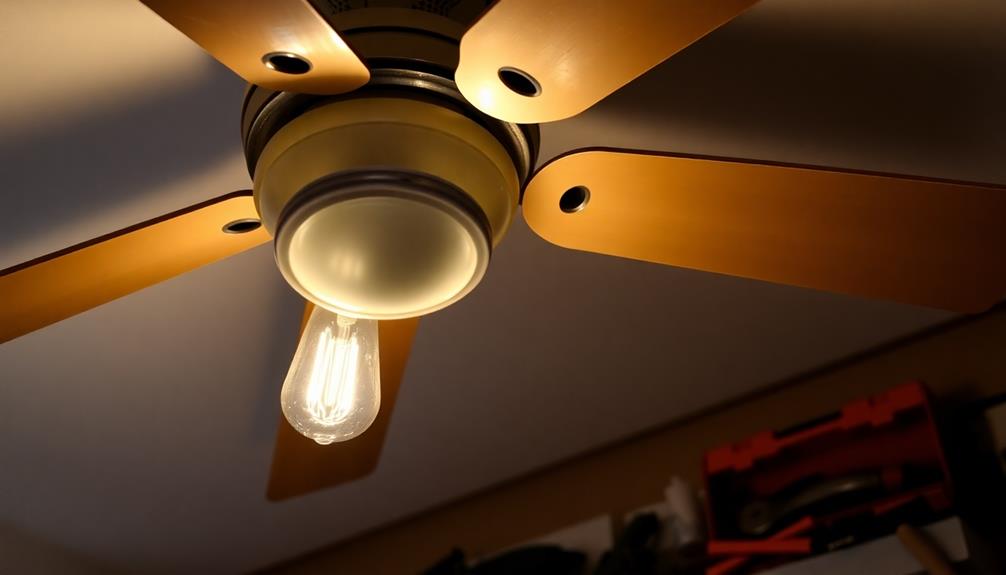If your ceiling fan's giving you trouble, you're not alone. Many issues arise from basic causes like incorrect settings, dust buildup on blades, or faulty wiring. Make certain your power supply's secure and check the fan's controls. Dust the blades regularly and guarantee proper installation for ideal airflow. If you notice unusual sounds, it might be time to inspect the motor or capacitor. Regular maintenance can enhance performance considerably. By addressing these common problems, you'll have a more efficient ceiling fan in no time—and there's plenty more you can discover about keeping it running smoothly.
Key Takeaways
- Check for incorrect fan settings or low speed selection that may affect performance.
- Clean blades regularly to prevent dust accumulation and enhance airflow.
- Inspect wiring connections and power supply to rule out electrical issues.
- Ensure proper installation and clearance around the fan for optimal airflow efficiency.
- Replace worn or damaged components to maintain smooth operation and performance.
Causes of Slow Operation

When you notice your ceiling fan running slower than usual, several factors could be at play. First, check the fan settings; you might've accidentally selected a lower speed.
Dust and debris build-up on the blades can also hinder performance, so make sure they're clean. If the motor or capacitor is faulty, you'll likely experience reduced speed as well.
Additionally, improper installation or mounting could restrict airflow, causing the fan to struggle. Ensuring your fan is properly installed and that there's enough clearance around it is essential for ideal airflow.
Moreover, just like how the best heat pumps require careful installation for efficiency, your ceiling fan should be mounted correctly for maximum performance.
Maintenance and Care Tips

Regular maintenance is key to keeping your ceiling fan running efficiently and effectively. Start by turning off the fan before cleaning. Use a soft cloth or a feather duster to wipe down the blades and remove dust.
For stubborn grime, a mild soap solution can help, but make sure to rinse thoroughly. Additionally, verifying that your fan is an Energy Star certified model can greatly enhance its efficiency and lower your energy bills.
Vacuum the fan's housing regularly to prevent debris buildup. Check the motor and other components periodically for any signs of wear or damage. Lubricate moving parts as needed to maintain smooth operation.
Confirm your fan is installed correctly with adequate clearance to avoid airflow obstructions. Following these tips will enhance your fan's performance and prolong its lifespan, guaranteeing it continues to provide comfort year-round.
Fan Design Impact
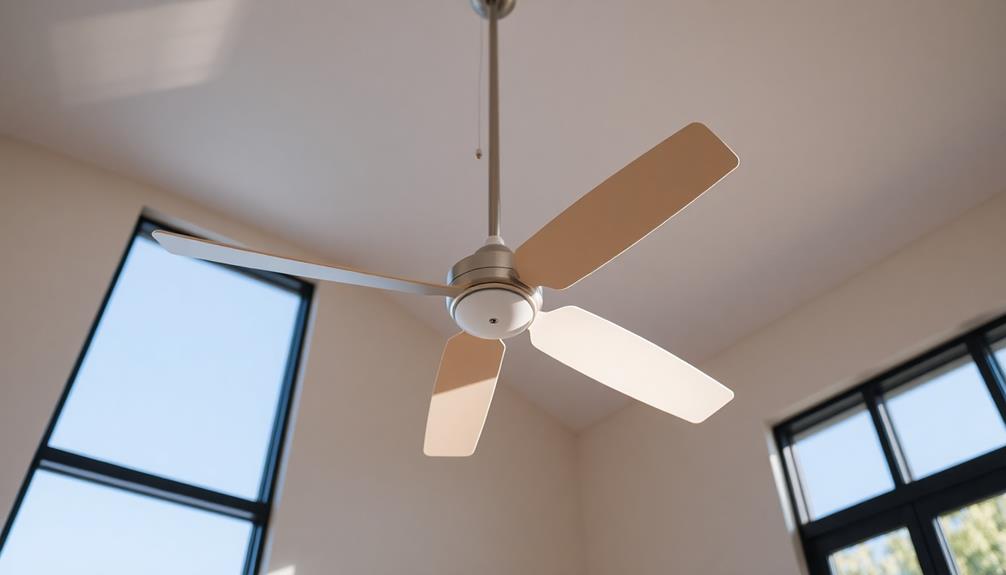
Understanding the impact of fan design is essential for maximizing your ceiling fan's effectiveness. The shape, size, and angle of the blades notably influence airflow and speed. Understanding the impact of fan design is essential for maximizing your ceiling fan's effectiveness. The shape, size, and angle of the blades notably influence airflow and speed. Modern innovations in blade construction seek to optimize movement while maintaining energy efficiency. For example, addressing Germany’s ceiling fan challenges, such as balancing quieter operation with effective cooling in compact spaces, has led to the development of more streamlined and versatile designs. These advancements demonstrate the importance of tailoring fan design to both regional needs and environmental considerations.
For instance, wider blades can move more air, but they may require more power. If your fan's design isn't optimized for your space, you might notice reduced performance.
Additionally, consider the mounting height; a fan mounted too high may struggle to circulate air efficiently. Be mindful of the blade condition, too; worn or damaged blades can drastically affect airflow.
Regularly examine your fan's design and its suitability for your room to make sure you're getting the most out of it. Adjustments or replacements may lead to improved performance and comfort in your space.
Electrical Troubleshooting

Electrical issues can often be the root cause of a ceiling fan's sluggish performance.
First, check the power supply; verify the fan is firmly plugged in and the circuit breaker isn't tripped.
Next, inspect the wiring connections for any signs of wear or loose connections.
If your fan uses a remote control or wall switch, test these components to rule out malfunction.
A faulty motor or capacitor can also lead to reduced speed, so listen for any unusual sounds when the fan operates.
If you notice persistent issues, consider consulting a professional for a thorough diagnosis.
Common Control Issues
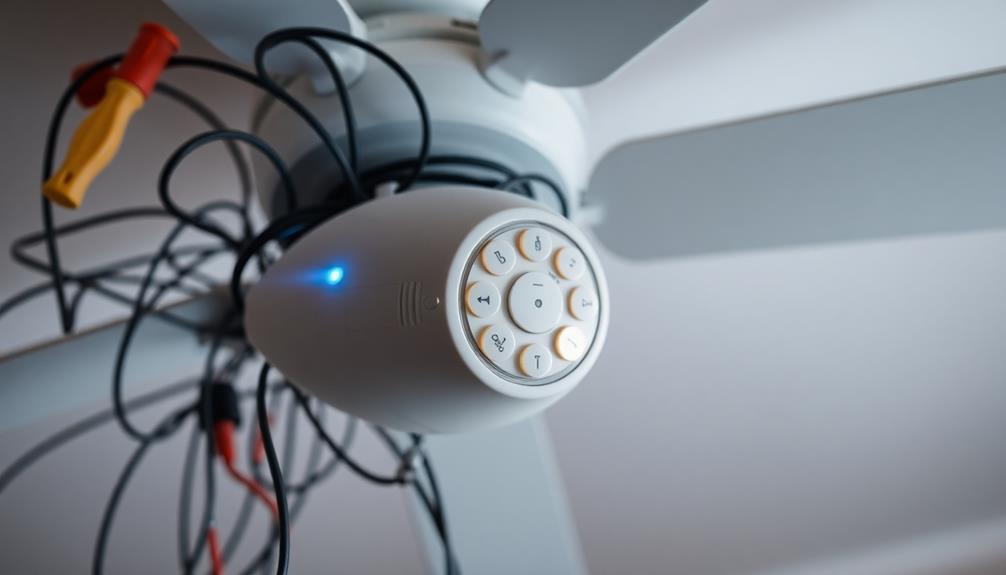
Control issues can considerably affect your ceiling fan's performance, often compounding any electrical problems you may have already encountered.
If your fan's remote control or wall switch is malfunctioning, you might experience inconsistent speeds or complete failure to operate. Check the batteries in your remote and verify the connections in the wall switch are secure.
Wiring issues can also lead to inadequate power delivery, which can slow down your fan. If you notice these problems persisting, it might be time to call in a professional for a thorough inspection.
Regularly monitoring your fan's controls will help you catch these issues early, confirming your fan runs efficiently and effectively when you need it most.
Cleaning Best Practices
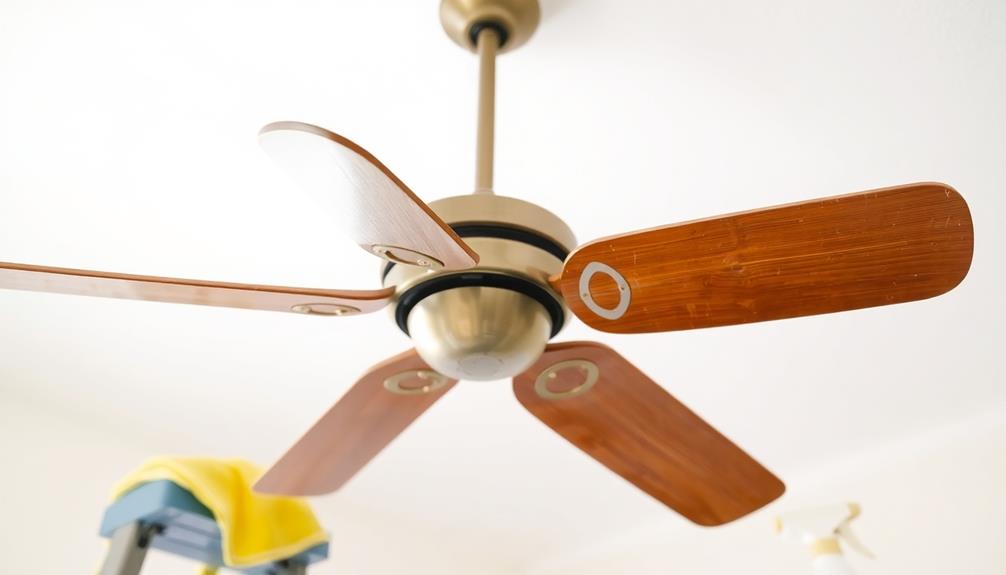
Regularly cleaning your ceiling fan is essential to maintain its performance and prolong its lifespan.
Start by turning off the fan and unplugging it if possible. Use a soft cloth or feather duster to gently wipe the blades, removing dust and debris that can cause imbalance.
For stubborn grime, mix mild soap with water, dampen a cloth, and gently scrub the blades before rinsing.
Don't forget to clean the motor housing and pull chain, as vacuuming these areas can prevent dust buildup.
Make certain to check the fan's mounting and confirm there's enough clearance around it.
Recommendations for Performance
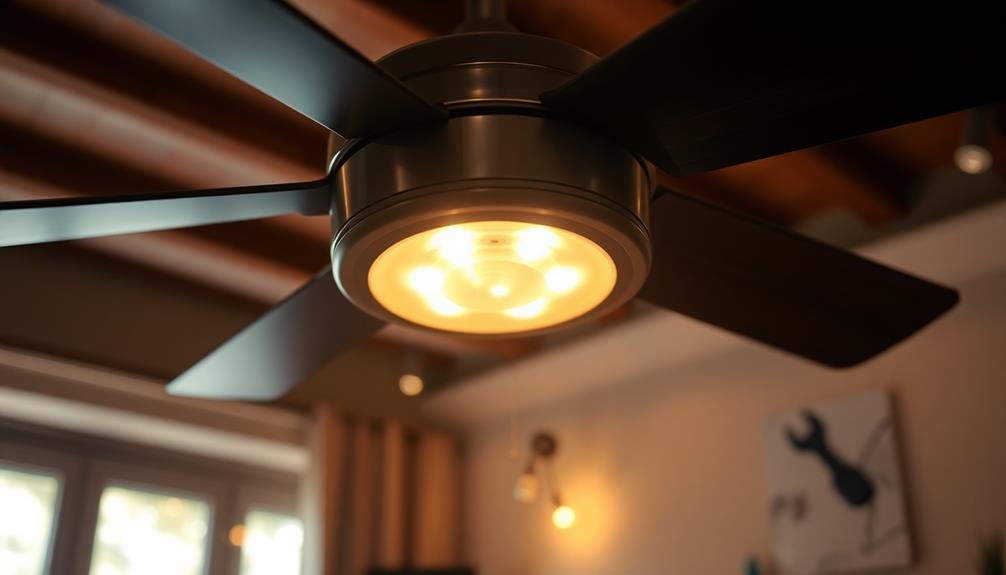
To guarantee your ceiling fan operates at peak performance, it's crucial to monitor and address any issues proactively.
Regular maintenance guarantees efficiency and longevity. Here are some recommendations to enhance your fan's performance:
- Adjust Fan Settings: Verify you use the correct speed setting for your needs, as incorrect settings can hinder airflow.
- Regular Cleaning: Keep blades free from dust and debris; a clean fan runs better and longer.
- Inspect Components: Check for any damaged parts, like motor or blades, and replace them if necessary.
Frequently Asked Questions
How Can I Tell if My Fan Blades Are Balanced?
To check if your fan blades are balanced, look for wobbling during operation. You can use a level or watch for uneven airflow. If there's an issue, consider adjusting or adding weights to the blades.
What Size Ceiling Fan Is Best for My Room?
Choosing the perfect ceiling fan size can feel like finding a needle in a haystack! For ideal airflow, measure your room's dimensions; typically, fans should span 36-60 inches, depending on space, ensuring a breezy oasis.
Can Ceiling Fans Improve Air Conditioning Efficiency?
Yes, ceiling fans can enhance air conditioning efficiency. By circulating cool air, they allow you to set your thermostat higher without sacrificing comfort, reducing energy costs while maintaining a pleasant indoor environment.
Are There Energy-Efficient Ceiling Fan Options Available?
Yes, you can find energy-efficient ceiling fan options that help reduce energy consumption. Look for those with ENERGY STAR ratings, as they use advanced technology to maximize airflow while minimizing electricity use, benefiting both your wallet and the environment.
How Often Should I Replace My Ceiling Fan?
You should consider replacing your ceiling fan every 10 years. Regularly check for performance issues, and if you notice decreased airflow or noise, it's time to upgrade for better efficiency and comfort.
Conclusion
Now that you know the common causes of your ceiling fan's sluggishness, imagine feeling the invigorating breeze of a well-functioning fan dancing through your space. By tackling maintenance and troubleshooting, you can transform your environment into a cool haven. Don't let dust and electrical issues dampen your comfort; take action today! With a little care, you'll enjoy a revitalized airflow that sweeps away the frustration and brings a soothing chill to your home.
